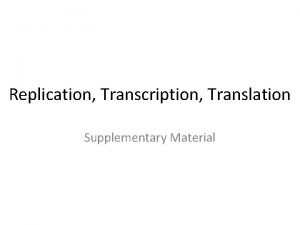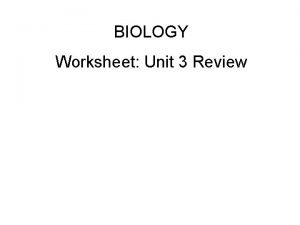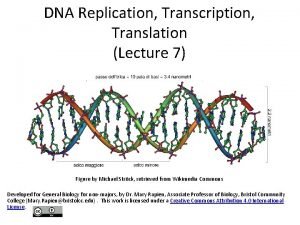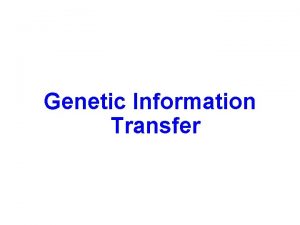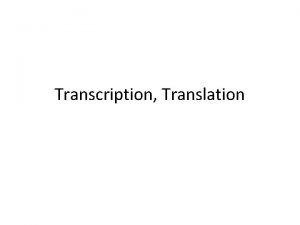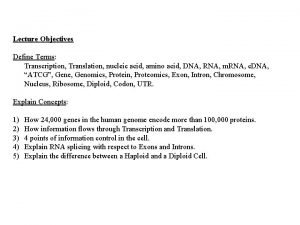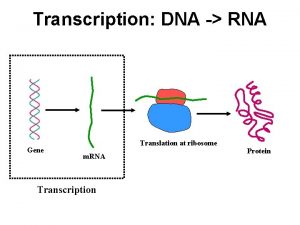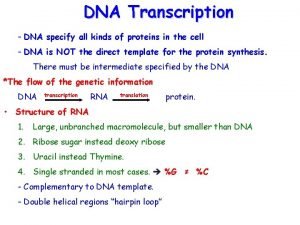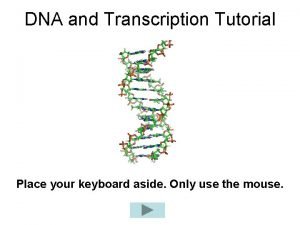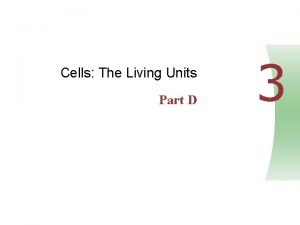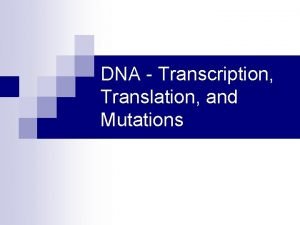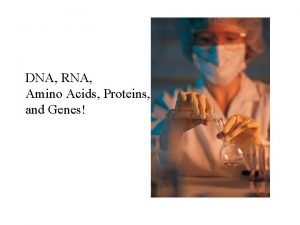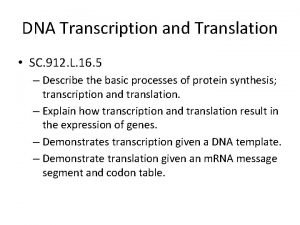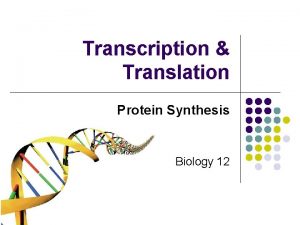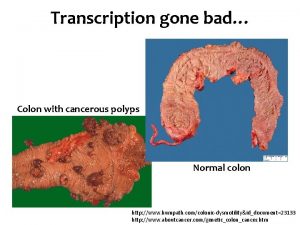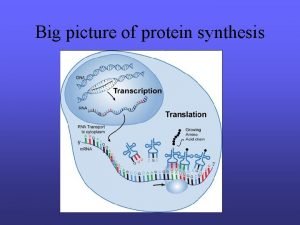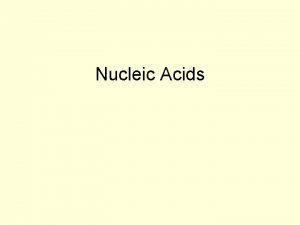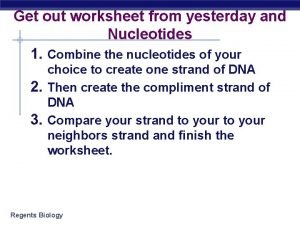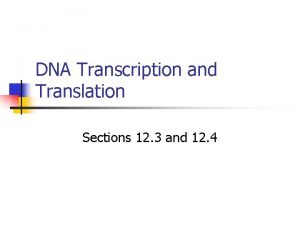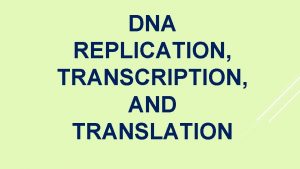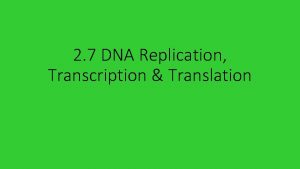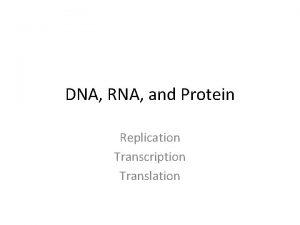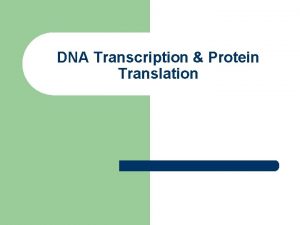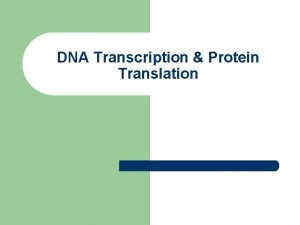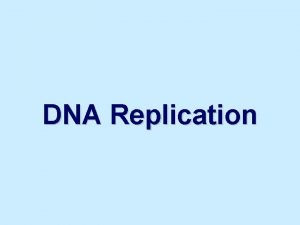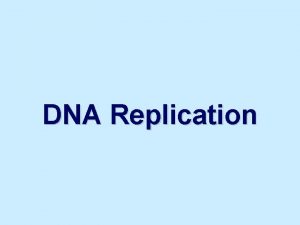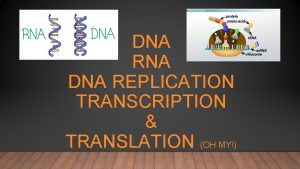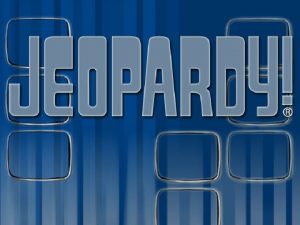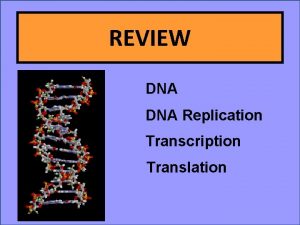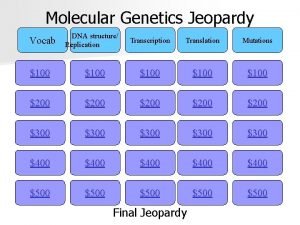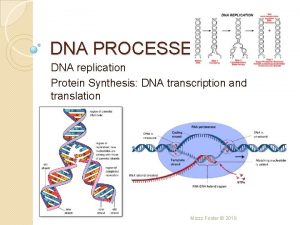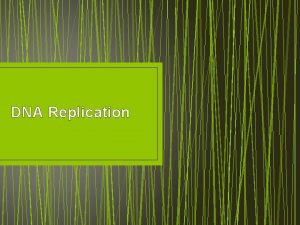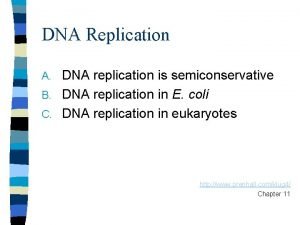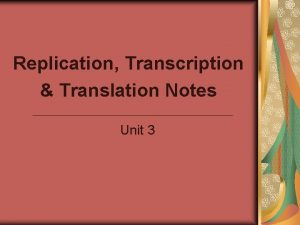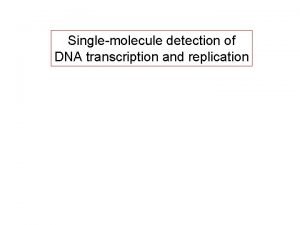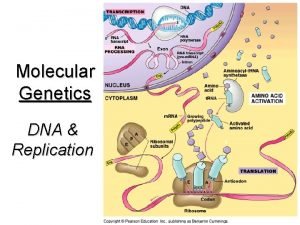Lecture 9 Molecular Genetics DNA Replication Transcription Translation































- Slides: 31

Lecture 9 Molecular Genetics DNA Replication, Transcription & Translation

______ Genomes • Prokaryotic genomes are made of DNA. • Prokaryotic chromosomes can be circular or linear. • Genome floats freely within cytoplasm • Where is DNA found in prokaryotes? – ______________ . Transmission electron micrograph of E. coli O 157: H 7 showing flagella. (Courtesy of the CDC)

______ Genomes • The genomes of eukaryotic organisms are made of DNA. • Eukaryotic genomes frequently include several to many linear chromosomes sequestered within membrane-bound nucleus (How many do we have? ). • Where is DNA found in eukaryotes? – Nuclear DNA – Extranuclear DNA (Where is extranuclear DNA? ) Human epithelial cells stained with DAPI (blue, to show the nucleus) and phallotoxin (red, to show Factin in the cell body) Courtesy of RL Alford, Ph. D

Nucleotides and Nucleic Acids

Organic Molecules – Nucleic Acids Image: www. geneticengineering. org/. . . /DNA. htm

Nucleic Acids - DNA is a double stranded molecule, analogous to a ladder. The “ladder” = • two deoxyribosephosphate chains form the “side rails” • base pairs, linked by hydrogen bonds, form the “rungs”. Purine Bases (double ring) Adenine & Guanine Pyrimidine Bases (single ring) Cytosine & Thymine Image: www. biologycorner. com/bio 1/DNA. html

Image: whyfiles. org/034 clone/dna. html

Nucleic Acid Function Replication Transcription Translation

Replication Copying the genetic material is REPLICATION. Replication occurs prior to ________, because the new, daughter cell will also need a complete copy of cellular DNA. Replication

DNA Replication • _____ a double-stranded DNA molecule. • Each DNA strand holds the same genetic information, so both strands can serve as templates for the reproduction of opposite strand. • The _____ or _____ strand is preserved and the ______ or ______ strand is assembled from nucleotides • This is called __________ replication. • The resulting double-stranded DNA molecules are identical. Replication

DNA Replication • In a cell, DNA replication must happen before cell division. • _____ replicate their DNA throughout the interval between cell divisions. • In ______, timings are highly regulated. Fluoresced E. coli colony: http: //ibis. inrialpes. fr/article. php 3? id_article=886 Root tip: http: //district. bluegrass. kctcs. edu/billd. snyder/sharedfiles/biowebsite/Biology. Labs/BIO 137/137 Lab 2/Lab 2 Mitosis. Slides. html

_______ DNA Replication: Replication “Bubbles” • Origin of replication (“bubbles”): beginning of replication • Replication fork: ‘Y’-shaped region where new strands of DNA are elongating Replication

________ DNA Replication: One Origin • Prokaryotic DNA is arranged in a circular shape, and there is only one replication origin when replication starts. • Despite these differences, the underlying process of replication is the same for both prokaryotic and eukaryotic DNA. Replication

How Do Nucleotides Put Themselves Together Into Nucleic Acids? • An anabolic polymerization process. - Anabolic or Anabolism is…. ? _______________ - Polymerization = taking monomers and putting them together into polymers (large molecules composed of many monomers). • Polymerization requires ______ (building blocks) and ____. - Triphosphate deoxyribonucleotides provide both. - These building blocks of DNA bring their own energy for polymerization. Replication

DNA Replication: _____ Nature of DNA • Sugar/phosphate backbone runs in opposite directions. • One strand runs 5’ to 3’, while the other runs 3’ to 5’. • DNA polymerase, enzyme that facilitates addition of nucleotides in building the new DNA strand, • Can only adds nucleotides at the free 3’ end Why is this important? Replication

DNA Replication: Leading & Lagging Strand ____ Strand Synthesis toward the replication fork (only the 3’ to 5’ of the master strand). ____ Strand Synthesis away from the replication fork (Okazaki fragments); joined by DNA ligase. Replication

DNA Replication VIDEO: http: //207. 4. 198/pub/flash/24/24. html

Reminder…Why is the DNA copied? Replication occurs prior to cell division, because the new, daughter cell will also need a complete copy of cellular DNA. Replication

Replication Mistakes: _____ of Genes • Change in the nucleotide base sequence of a genome; rare. • Almost always deleterious (bad). • Rarely lead to a protein having a novel property that improves ability of organism and its descendents to survive and reproduce.

Nucleic Acid Function Replication Transcription Translation

Replication & Transcription MAKING DNA Making a copy of the genetic material = ______. When you think “replication” think “duplication” MAKING RNA Transferring the genetic code (DNA) into RNA = ________. Think of a medical transcriptionist. (S)he is just copying the physicians words into another format.

Nucleic Acids - RNA is typically a singlestranded molecule Purine Bases (double ring) Adenine & Guanine Pyrimidine Bases (single ring) Cytosine & Uracil Base Pairs (purine always pairs with pyrimidine) __________ + _________ Image: www. biologycorner. com/bio 1/DNA. html

Transcription Process by which a DNA sequence is copied to produce a complementary RNA. In other words, it is the transfer of genetic information from DNA into RNA. Like replication, but we are making RNA. Beginning of the process that ultimately leads to the translation of the genetic code (via m. RNA) into a peptide or protein. Transcription

Types of RNA Genetic information copied from DNA is transferred to 3 types of RNA: _____ RNA: m. RNA Copy of information in DNA that is brought to the ribosome and translated into protein by t. RNA & r. RNA _____ RNA: r. RNA Most of the RNA in cells is associated with structures known as ribosomes, the protein factories of the cells. It is the site of translation where genetic information brought by m. RNA is translated into actual proteins. ______ RNA: t. RNA Brings the amino acid to the ribosome that m. RNA coded for. Transcription & Translation

Nucleic Acid Function Replication Transcription Translation

Replication, Transcription, Translation MAKING DNA Making a copy of the genetic material = Replication When you think “replication” think “duplication” Where does replication occur in prokaryotes? Eukaryotes? MAKING RNA Transferring genetic code (DNA) to RNA = Transcription Think of a medical transcriptionist. (S)he is just copying the physicians words into another format. Where does transcription occur in prokaryotes? Eukaryotes? MAKING PROTEINS Making proteins = _______. Think of how translation relates to languages. The translation of cell biology translates DNA information into proteins.

Translation _______ (which contain r. RNA) make proteins from the messages encoded in m. RNA. – Three nucleotide groups called _______ encode one amino acid. – This is the genetic code. Nearly completed protein Beginning of protein Ribosome 5' 3' m. RNA Adapted from: L. Stryer. Biochemistry, 3 rd ed. . Translation

Translation: The _______ • The genetic instructions for a polypeptide chain are ‘written’ in the DNA as a series of 3 -nucleotide ‘words’ • ______ on m. RNA • ______ on t. RNA • ‘U’ (uracil) replaces ‘T’ in RNA • Where does translation occur in prokaryotes? Eukaryotes? http: //learn. genetics. utah. edu/units/basics/transcribe/ http: //207. 4. 198/pub/flash/26/26. html

Transcription & Translation: Overview Eukaryotic Cell _______ Synthesis of RNA under the direction of DNA (m. RNA) _______ Actual synthesis of a polypeptide (protein) under the direction of m. RNA

Transcription & Translation

Replication, Transcription & Translation: Overview
 Dna replication transcription and translation
Dna replication transcription and translation Bioflix activity dna replication dna replication diagram
Bioflix activity dna replication dna replication diagram Transcription translation replication
Transcription translation replication Transcription translation replication
Transcription translation replication Dna meaning
Dna meaning Replication transcription translation
Replication transcription translation Transcription and translation coloring
Transcription and translation coloring Dna transcription and translation
Dna transcription and translation Replication
Replication Dna rna protein synthesis homework #2 dna replication
Dna rna protein synthesis homework #2 dna replication Chapter 12 section 1 dna the genetic material
Chapter 12 section 1 dna the genetic material Replication vs transcription venn diagram
Replication vs transcription venn diagram Rna
Rna Dna transcription
Dna transcription Dna and transcription tutorial
Dna and transcription tutorial Transcription initiation in eukaryotes
Transcription initiation in eukaryotes Dna to rna transcription
Dna to rna transcription Dna code
Dna code Dna transcription
Dna transcription Dna transcription
Dna transcription Overview of transcription and translation
Overview of transcription and translation Protein synthesis gcse
Protein synthesis gcse Translation transcription
Translation transcription Transcription or translation
Transcription or translation Translation transcription
Translation transcription Translation protein synthesis
Translation protein synthesis Picture of protein synthesis
Picture of protein synthesis Transcription and translation
Transcription and translation Biology transcription and translation
Biology transcription and translation Rna matching
Rna matching Venn diagram of dna and rna
Venn diagram of dna and rna Transcription
Transcription


